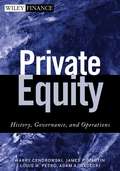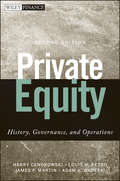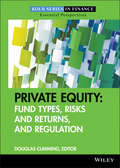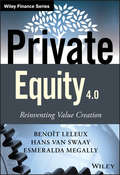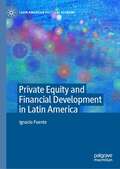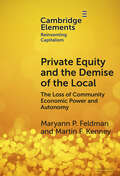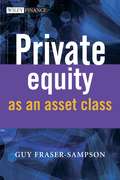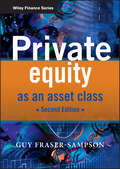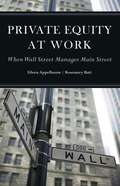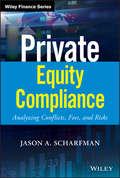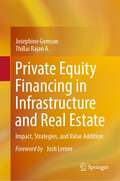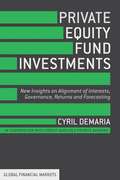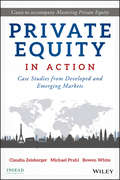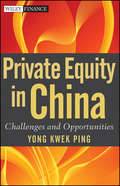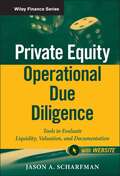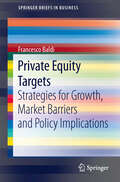- Table View
- List View
Private Equity: History, Governance, and Operations (Wiley Finance #18)
by Harry Cendrowski James P. Martin Louis W. Petro Adam A. WadeckiPraise for Private Equity "Private Equity: History, Governance, and Operations is an invaluable guide to understanding the world of private equity investing. Harry Cendrowski and his colleagues have drawn on their extensive experience and expertise to produce a book that is remarkably comprehensive and authoritative." —Robert Larson, Chairman, Lazard Real Estate Partners LLC and Larson Realty Group Managing Director, Lazard Alternative Investments "Private Equity: History, Governance, and Operations is an essential text for any business/finance professional's library. Applicable to both seasoned private equity gurus and students of the industry, its in-depth analysis of 'Best Practices' is well researched and clearly written." —William Campbell, Managing Director, W.Y. Campbell & Company "This is an interesting and very well-written book. It not only clearly describes the history and techniques of private equity investing, it also provides a thorough examination of the rarely appreciated relationships among internal control design and operation, corporate governance and sound investment decision-making and management. It is an important contribution to the literature of finance." —Barry Epstein, PhD, CPA, Partner, Russell Novak & Company, LLP, and author of Wiley GAAP 2008, The Handbook of Accounting and Auditing, and Wiley IFRS 2008 "Harry Cendrowski really hits a homerun with his newest book about the private equity (PE) industry. A definitive, authoritative text on the subject, it answered all my questions, plus some, and gave me a complete frame of reference where I now feel well informed on PE. I would recommend this book to anyone connected to the PE industry, business advisors, academics, and business owners." —Parnell Black, MBA, CPA, CVA, Chief Executive Officer, National Association of Certified Valuation Analysts (NACVA) "The timing could not be better to learn more about the current best practices and governance in the world of private equity. What was once an exclusive asset class reserved for the largest, most sophisticated investors has now become a mainstream alternative investment option for investors of all sizes. Still, many investors do not fully understand how the business works. Private Equity: History, Governance, and Operations endows its readers with an A-to-Z education on this emerging asset class, irrespective of their previous experiences." —Maribeth S. Rahe, President and Chief Executive Officer, Fort Washington Investment Advisors, Inc. & Fort Washington Capital Partners "As a private equity practitioner in the financial services space, I found this book to be a comprehensive-and comprehendible-resource covering all relevant aspects of the business of private equity. This book provides valuable 'how-to's' for improving the likelihood of having successful portfolio companies, with successful exits. Furthermore, both veteran and prospective PE investors now have a resource available to help them screen PE opportunities that best fit with their risk and return objectives." —Scott B. McCallum, Principal, Resource Financial Institutions Group, Inc. "For years, private equity has been a misunderstood asset class. Harry Cendrowski's book defines private equity in clear, concise terms. Anyone in the financial world will benefit from the insights, guidelines, and experiences detailed in Private Equity: History, Governance, and Operations." —Bob Clone, Senior Portfolio Manager, Alternative Investments Division, Michigan Department of Treasury
Private Equity
by Harry Cendrowski Adam A. Wadecki Louis W. Petro James P. MartinPraise for Private Equity"Private Equity: History, Governance, and Operations is an invaluable guide to understanding the world of private equity investing. Harry Cendrowski and his colleagues have drawn on their extensive experience and expertise to produce a book that is remarkably comprehensive and authoritative."--Robert Larson, Chairman, Lazard Real Estate Partners LLC and Larson Realty Group Managing Director, Lazard Alternative Investments"Private Equity: History, Governance, and Operations is an essential text for any business/finance professional's library. Applicable to both seasoned private equity gurus and students of the industry, its in-depth analysis of 'Best Practices' is well researched and clearly written."--William Campbell, Managing Director, W.Y. Campbell & Company"This is an interesting and very well-written book. It not only clearly describes the history and techniques of private equity investing, it also provides a thorough examination of the rarely appreciated relationships among internal control design and operation, corporate governance and sound investment decision-making and management. It is an important contribution to the literature of finance."--Barry Epstein, PhD, CPA, Partner, Russell Novak & Company, LLP, and author of Wiley GAAP 2008, The Handbook of Accounting and Auditing, and Wiley IFRS 2008"Harry Cendrowski really hits a homerun with his newest book about the private equity (PE) industry. A definitive, authoritative text on the subject, it answered all my questions, plus some, and gave me a complete frame of reference where I now feel well informed on PE. I would recommend this book to anyone connected to the PE industry, business advisors, academics, and business owners."--Parnell Black, MBA, CPA, CVA, Chief Executive Officer, National Association of Certified Valuation Analysts (NACVA)"The timing could not be better to learn more about the current best practices and governance in the world of private equity. What was once an exclusive asset class reserved for the largest, most sophisticated investors has now become a mainstream alternative investment option for investors of all sizes. Still, many investors do not fully understand how the business works. Private Equity: History, Governance, and Operations endows its readers with an A-to-Z education on this emerging asset class, irrespective of their previous experiences."--Maribeth S. Rahe, President and Chief Executive Officer, Fort Washington Investment Advisors, Inc. & Fort Washington Capital Partners"As a private equity practitioner in the financial services space, I found this book to be a comprehensive-and comprehendible-resource covering all relevant aspects of the business of private equity. This book provides valuable 'how-to's' for improving the likelihood of having successful portfolio companies, with successful exits. Furthermore, both veteran and prospective PE investors now have a resource available to help them screen PE opportunities that best fit with their risk and return objectives."--Scott B. McCallum, Principal, Resource Financial Institutions Group, Inc."For years, private equity has been a misunderstood asset class. Harry Cendrowski's book defines private equity in clear, concise terms. Anyone in the financial world will benefit from the insights, guidelines, and experiences detailed in Private Equity: History, Governance, and Operations."--Bob Clone, Senior Portfolio Manager, Alternative Investments Division, Michigan Department of Treasury
Private Equity: Fund Types, Risks and Returns, and Regulation (Robert W. Kolb Series #10)
by Douglas CummingA comprehensive look at the private equity arena With private equity differing from other asset classes, it requires a whole new approach for those trained in more traditional investments such as stocks and bonds. But with the right guidance, you can gain a firm understanding of everything private equity has to offer. This reliable resource provides a comprehensive view of private equity by describing the current state of research and best practices in this arena. Issues addressed include the structure of private equity funds and fundraising, the financial and real returns of private equity, and the structure of private equity investments with investees, to name a few. Discusses the role of private equity in today's financial environment Provides international perspectives on private equity Details the regulation of private equity markets Filled with in-depth insights and expert advice, this book will provide you with a better understanding of private equity structures and put you in a better position to measure and analyze their performance.
Private Equity
by Paul Jowett Francoise JowettThis tells the story of the development of the private equity industry in Germany. It is the first comprehensive history of the private equity industry for any country, revealing the vicissitudes of private equity investing, warts and all. It is anengaging chroniclefor anyone interested in the industry or the modern German economy. "
Private Equity: A Memoir
by Carrie SunNamed a most-anticipated book of 2024 by NPR.org, Oprah Daily, Town & Country, The Millions, Financial Times, and more.A gripping memoir of one woman&’s self-discovery inside a top Wall Street firm, and an urgent indictment of privilege, extreme wealth, and work cultureWhen we meet Carrie Sun, she can&’t shake the feeling that she&’s wasting her life. The daughter of Chinese immigrants, Carrie excelled in school, graduated early from MIT, and climbed the corporate ladder, all in pursuit of the American dream. But at twenty-nine, she&’s left her analyst job, dropped out of an MBA program, and is trapped in an unhappy engagement. So when she gets the rare opportunity to work at one of the most prestigious hedge funds in the world, she knows she can&’t say no. Fourteen interviews later, she&’s in.Carrie is the sole assistant to the firm&’s billionaire founder. She manages his work life, becoming the right hand to an investor who can move mountains and markets with a single phone call. Eager to impress, she dives headfirst into the firm&’s culture, which values return on time above all else. A luxury-laden world opens up for her, and Carrie learns that money can solve nearly everything.Playing the game at the highest levels, amid the ultimate winners in our winner-take-all economy, Carrie soon finds her identity swallowed whole by work. With her physical and mental health deteriorating, she begins to rethink what it actually means to waste one&’s life. A searing examination of our relationship to work, Carrie&’s story illuminates the struggle for balance in a world of extremes: efficiency and excess, status and aspiration, power and fortune. Private Equity is a universal tale of self-invention from a dazzling new voice, daring to ask what we&’re willing to sacrifice to get to the top—and what it might take to break free and leave it all behind.
Private Equity 4.0: Reinventing Value Creation (The Wiley Finance Series)
by Benoît Leleux Hans van Swaay Esmeralda Megally“Private equity is more economically significant than ever, as institutions hunt for high returns in a risky world. Private Equity 4.0 examines the role, workings and contribution of this important industry in a straightforward yet revealing manner.” Dr. Josh LernerJacob H. Schiff Professor of Investment Banking Chair, Entrepreneurial Management Unit Harvard Business School A multi-perspective look at private equity's inner workings Private Equity 4.0 provides an insider perspective on the private equity industry, and analyzes the fundamental evolution of the private equity asset class over the past 30 years, from alternative to mainstream. The book provides insightful interviews of key industry figures, and case studies of some of the success stories in the industry. It also answers key questions related to strategy, fund manager selection, incentive mechanisms, performance comparison, red flags in prospectuses, and more. Private Equity 4.0 offers guidance for the many stakeholders that could benefit from a more complete understanding of this special area of finance. Understand the industry's dominant business models Discover how value is created and performance measured Perform a deep dive into the ecosystem of professionals that make the industry hum, including the different incentive systems that support the industry's players Elaborate a clear set of guidelines to invest in the industry and deliver better performance Written by a team of authors that combine academic and industry expertise to produce a well-rounded perspective, this book details the inner workings of private equity and gives readers the background they need to feel confident about committing to this asset class. Coverage includes a historical perspective on the business models of the three major waves of private equity leading to today's 4.0 model, a detailed analysis of the industry today, as well as reflections on the future of private equity and prospective futures. It also provides readers with the analytical and financial tools to analyze a fund's performance, with clear explanations of the mechanisms, organizations, and individuals that make the system work. The authors demystify private equity by providing a balanced, but critical, review of its contributions and shortcomings and moving beyond the simplistic journalistic descriptions. Its ecosystem is complex and not recognizing that complexity leads to inappropriate judgments. Because of its assumed opacity and some historical deviant (and generally transient) practices, it has often been accused of evil intents, making it an ideal scapegoat in times of economic crisis, prodding leading politicians and regulators to intervene and demand changes in practices. Unfortunately, such actors were often responding to public calls for action rather than a thorough understanding of the factors at play in this complex interdependent system, doing often more harm than good in the process and depriving economies of one of their most dynamic and creative forces. Self-regulation has clearly shown its limits, but righteous political interventions even more so. Private equity investment can be a valuable addition to many portfolios, but investors need a clear understanding of the forces at work before committing to this asset class. With detailed explanations and expert insights, Private Equity 4.0 is a comprehensive guide to the industry ways and means that enables the reader to capture its richness and sustainability.
Private Equity and Financial Development in Latin America (Latin American Political Economy)
by Ignacio PuenteShallow capital markets are a key bottleneck for private sector development in Latin America. Still, there is not a large literature on capital markets and corporate governance, or on the politics of regulatory reform and business associations, focused on this region. To help address this gap, this new book introduces private equity into the financial development debate through a Latin American lens. The author looks at the cases of Brazil, Mexico, Chile, Colombia, and Argentina. And proposes a shift in the financial development discussion from institutional explanations focused only on rules to an actor-based argument centered on the role of institutional investors, in particular pension funds .
Private Equity and the Demise of the Local: The Loss of Community Economic Power and Autonomy (Elements in Reinventing Capitalism)
by Maryann Feldman Martin KenneyCapitalism is a powerful engine that requires finance. Private equity is part of the neoliberal transformation of capitalism that has failed the average citizen and unleashed a tsunami of leveraged acquisitions that have destroyed entire sectors of our economy. Private equity has become a powerful force that has moved from restructuring industrial firms to buying up just about any economic activity in local communities that has assets that can be monetized, without any consideration of the impact on the quality of life and well-being of the community. Th a process has been aided and abetted by government policy. The authors of this Element explain the workings of the private equity model and the reasons it has been so profitable. They document the effects of PE on firms and communities by examining a range of activities that once had a local focus. They conclude by offering policy recommendations.
Private Equity and Venture Capital: Theory, Evolution and Valuation (Contributions to Finance and Accounting)
by Serena Gallo Vincenzo VerdolivaThe terms venture capital and private equity may differ across countries. This book discusses venture capital not only as risk capital toward unlisted companies with the aim to enhance the investee firm, but also analyses broader forms of entrepreneurial investment: from early stage financing to buyout and turnaround transaction. This book is divided into four sections. The first section aims to shed light on the terminology and offers a comparison between private equity/venture capital, and the traditional banking sector as financing sources. The second section details the differences between private equity and venture capital transactions on the basis of firm life cycle, and summarizes the main characteristics of both private equity and venture capital investors and investee firms. The third section illustrates the evolution of the private equity and venture capital industry before and after the financial crisis by looking at three fundamental aspects: fundraising, investment and divestment, all in terms of volume and trends. The last section discusses the basic elements of corporate valuation applied to private equity and venture capital industry, with some practical examples.
Private Equity as an Asset Class
by Fraser-Sampson GuyGuy Fraser-Sampson draws upon twenty years' private equity experience to provide a practical guide to mastering the intricacies of this highly specialist asset class. Aimed equally at investors, professionals and business school students, it starts with such fundamental questions as "what is private equity?" and progresses to detailed analysis of venture and buyout returns. It also unveils a totally new concept which looks set to revolutionise thinking in the industry: Total Return investing. Often unfairly reviled, and frequently misunderstood, private equity differs from all other asset classes in various important respects, not least in the nature and timing of its returns, which require a whole new approach for those reared on more traditional investments such as bonds and shares. This book shows how a good grasp of the basic structure of private equity vehicles and returns (including the dreaded J-curve) can lead to full understanding of the techniques needed to measure and analyse performance. Key points include: A glossary of private equity terms Venture funds and transactions Buyout funds and transactions Understanding private equity returns Analysis of historic returns How to plan a fund investment programme How to conduct effective due diligence Total Return investing
Private Equity as an Asset Class
by Guy Fraser-SampsonUnfairly reviled, and much misunderstood, private equity differs from all other asset classes in various important respects, not least the way in which its fund mechanisms operate, and the way in which its returns are recorded and analysed. Sadly, high level asset allocation decisions are frequently made on the basis of prejudice and misinformation, rather than a proper appreciation of the facts.Guy Fraser-Sampson draws upon more than twenty years of experience of the private equity industry to provide a practical guide to mastering the intricacies of this highly specialist asset class. Aimed equally at investors, professionals and business school students, it starts with such fundamental questions as 'what is private equity?' and progresses to detailed consideration of different types of private equity activity such as venture capital and buyout.Rapid and significant changes in the environment during the recent financial crisis have prompted the need for a new edition. Separate chapters have been added on growth and development capital, as well as secondary investing. Newly emergent issues are considered, such as lengthening holding periods and the possible threat of declining returns. Particular problems, such as the need to distinguish between private equity and hedge funds, are addressed. The glossary has also been expanded. In short, readers will find that this new edition takes their understanding of the asset class to new heights.Key points include:A glossary of private equity termsVenture capitalBuyoutGrowth capitalDevelopment capitalSecondary investingUnderstanding private equity returnsAnalysing funds and returnsHow to plan a fund investment programmeDetailed discussion of industry performance figures
Private Equity at Work: When Wall Street Manages Main Street
by Eileen Appelbaum Rosemary BattPrivate equity firms have long been at the center of public debates on the impact of the financial sector on Main Street companies. Are these firms financial innovators that save failing businesses or financial predators that bankrupt otherwise healthy companies and destroy jobs? The first comprehensive examination of this topic, Private Equity at Work provides a detailed yet accessible guide to this controversial business model. Economist Eileen Appelbaum and Professor Rosemary Batt carefully evaluate the evidence—including original case studies and interviews, legal documents, bankruptcy proceedings, media coverage, and existing academic scholarship—to demonstrate the effects of private equity on American businesses and workers. They document that while private equity firms have had positive effects on the operations and growth of small and mid-sized companies and in turning around failing companies, the interventions of private equity more often than not lead to significant negative consequences for many businesses and workers. Prior research on private equity has focused almost exclusively on the financial performance of private equity funds and the returns to their investors. Private Equity at Work provides a new roadmap to the largely hidden internal operations of these firms, showing how their business strategies disproportionately benefit the partners in private equity firms at the expense of other stakeholders and taxpayers. In the 1980s, leveraged buyouts by private equity firms saw high returns and were widely considered the solution to corporate wastefulness and mismanagement. And since 2000, nearly 11,500 companies—representing almost 8 million employees—have been purchased by private equity firms. As their role in the economy has increased, they have come under fire from labor unions and community advocates who argue that the proliferation of leveraged buyouts destroys jobs, causes wages to stagnate, saddles otherwise healthy companies with debt, and leads to subsidies from taxpayers. Appelbaum and Batt show that private equity firms’ financial strategies are designed to extract maximum value from the companies they buy and sell, often to the detriment of those companies and their employees and suppliers. Their risky decisions include buying companies and extracting dividends by loading them with high levels of debt and selling assets. These actions often lead to financial distress and a disproportionate focus on cost-cutting, outsourcing, and wage and benefit losses for workers, especially if they are unionized. Because the law views private equity firms as investors rather than employers, private equity owners are not held accountable for their actions in ways that public corporations are. And their actions are not transparent because private equity owned companies are not regulated by the Securities and Exchange Commission. Thus, any debts or costs of bankruptcy incurred fall on businesses owned by private equity and their workers, not the private equity firms that govern them. For employees this often means loss of jobs, health and pension benefits, and retirement income. Appelbaum and Batt conclude with a set of policy recommendations intended to curb the negative effects of private equity while preserving its constructive role in the economy. These include policies to improve transparency and accountability, as well as changes that would reduce the excessive use of financial engineering strategies by firms. A groundbreaking analysis of a hotly contested business model, Private Equity at Work provides an unprecedented analysis of the little-understood inner workings of private equity and of the effects of leveraged buyouts on American companies and workers. This important new work will be a valuable resource for scholars, policymakers, and the informed public alike.
Private Equity Compliance: Analyzing Conflicts, Fees, and Risks (Wiley Finance)
by Jason A. ScharfmanDevelop and manage a private equity compliance program Compliance has become one of the fastest-growing areas in the private equity (PE) space. Mirroring trends from the hedge fund industry, recent surveys indicate that PE managers rank compliance as the single most challenging aspect of their business. Reports also indicate that PE compliance spending has rapidly outpaced other PE operating costs with recent estimates indicating that individual PE funds on average spend at least 15 - 20% of their operating budgets on this area. General Partners (GPs) have also significantly ramped up the hiring of private equity compliance related roles. Private Equity Compliance provides current and practical guidance on key private equity (PE) compliance challenges and trends. Packed with detailed, practical guidance on developing and managing a private equity compliance program, it offers up-to-date case studies and an analysis of critical regulatory enforcement actions on private equity funds in areas including conflict of interest, fees, expenses, LP fun raising disclosures, and valuations. • Provides real-world compliance guidance • Offers information that is tailored to the current compliance practices employed by GPs in the private equity industry. • Provides guidance on managing the compliance risks associated with cybersecurity and information technology risk • Serves as a PE-focused complement to the author's previous book, Hedge Fund Compliance If you’re a private equity investor or compliance officer looking for trusted guidance on analyzing conflicts, fees, and risks, this is one reference you can’t be without.
Private Equity Exits
by Paul A. Gompers Timothy DoreThis note presents statistics on private equity exits and discusses important issues relating to the most common exits routes.
Private Equity Finance Vignettes: 2016
by Paul A. Gompers Victoria IvashinaThis case contains four vignettes that provide an introduction to the issues covered in the course, Private Equity Finance.
Private Equity Financing in Infrastructure and Real Estate: Impact, Strategies, and Value Addition
by Josephine Gemson Thillai Rajan A.This book provides a comprehensive overview of Private Equity (PE) financing in the infrastructure and real estate sectors. In doing so, it analyzes the impact of such investments in the two sectors, evaluates the types of financing strategies, and explores the value created by such investments. Infrastructure and Real Estate have emerged as a significant asset class for PE investors. In the last three decades, PE firms have invested significant amounts of capital in infrastructure and real estate – sectors which did not feature in their radar before 2000. Between 2000 and 2009, PE firms invested more than USD 200 billion in infrastructure. Real estate sector also witnessed investments of a similar scale as that of infrastructure. Fundraising for infrastructure and real estate was about USD 100 billion and USD 150 billion respectively in 2019, setting new records and reaching all-time highs. This book examines such PE investments – both at a global level and at an emerging economy level, to identify how PE firms have created an impact with their investments, to provide both ready capital and value-addition to sectors which seem to urgently need both. The book is divided into three sections – impact of PE investments, strategies used by PE firms, and value created by such investments. The findings of this research and the corresponding best practices are useful and applicable to students, academicians, researchers, financial institutions, policy makers and law makers, commercial banks and funding agencies, practitioners, the Government, and other parties who are directly or indirectly associated with the development of infrastructure and real estate; and could aid funding agencies, practitioners and policy makers who are directly responsible for creating and developing infrastructure and real estate for their economies.
Private Equity Fund Investments
by Cyril DemariaThis book presents new, advanced, evidence-based guidance on investing in private equity funds: first by assessing the investor's environment and motivations, then by looking into the risks, returns and overall performance of funds and finally, by offering practical solutions to the illiquidity conundrum.
Private Equity in Action: Case Studies from Developed and Emerging Markets
by Bowen White Claudia Zeisberger Michael PrahlGlobal Best Practice in Private Equity Investing Private Equity in Action takes you on a tour of the private equity investment world through a series of case studies written by INSEAD faculty and taught at the world's leading business schools. The book is an ideal complement to Mastering Private Equity and allows readers to apply core concepts to investment targets and portfolio companies in real-life settings. The 19 cases illustrate the managerial challenges and risk-reward dynamics common to private equity investment. The case studies in this book cover the full spectrum of private equity strategies, including: Carve-outs in the US semiconductor industry (LBO) Venture investing in the Indian wine industry (VC) Investing in SMEs in the Middle East Turnaround situations in both emerging and developed markets Written with leading private equity firms and their advisors and rigorously tested in INSEAD's MBA, EMBA and executive education programmes, each case makes for a compelling read.As one of the world's leading graduate business schools, INSEAD offers a global educational experience. The cases in this volume leverage its international reach, network and connections, particularly in emerging markets.Private Equity in Action is the companion to Mastering Private Equity: Transformation via Venture Capital, Minority Investments & Buyouts, a reference for students, investors, finance professionals and business owners looking to engage with private equity firms. From deal sourcing to exit, LBOs to responsible investing, operational value creation to risk management, Mastering Private Equity systematically covers all facets of the private equity life cycle.
Private Equity in China
by Kwek Ping YongLearn valuable lessons from the newly successful private equity players in China and explore the challenges and opportunities offered in Chinese marketsThe first book to deal with private equity finance in China, Private Equity in China: Challenges and Opportunities provides much-needed guidance on an investment concept that has so far proved elusive in Asia. Focusing on the opportunities that the Chinese finance market offers to private equity firms, the book shows how these firms can strategically position themselves in order to maximize success in this new marketplace.Private Equity in China includes in-depth case studies illustrating both successful and failed ventures by private equity firms operating in China, outlining the challenges faced by private equity firms in setting up new funds. It contains a collection of valuable experience and insights about acquiring companies and turning them around essential for any firm currently operating in, or considering entering, the Chinese market.Discusses the challenges faced by private equity firms in China including setting up the initial fund, fund raising, deal sourcing, deal execution, and monitoring and exit strategiesProvides key insights drawn from keen observations and knowledge of the more mature private equity market in Western countries, analyzing the way forward for the Chinese private equity industryDiscusses the role of renminbi-denominated funds in the development of the private equity industry in ChinaBreaking new ground in exploring and explaining the private equity market in China, the book offers incredible new insight into how equity companies can thrive in the Chinese marketplace.
Private Equity in Emerging Markets
by Darek KlonowskiPrivate Equity in Poland focuses on the private equity industry and emerging markets in Poland. Poland represents the most developed private equity industry in Central and Eastern Europe and is one of the most developed emerging markets worldwide
Private Equity in Germany: Venture Capital for Digital Platform Start-ups (Business Guides on the Go)
by Cordelia Friesendorf Navid J. Mir HaschemiStart-ups are emerging, non-conventional enterprises that enter established markets with radically different products, displace incumbents, create new markets, and promote economic growth through innovation. Start-ups are often faced with many challenges that may threaten their survival, which can often be overcome by securing steady financial support. Start-ups are high-risk enterprises that are unattractive to conventional financiers, but absolutely suited to private equity (PE) and venture capital (VC) investors who seek rewards and are therefore willing to accept risk. The success stories of global digital platform start-ups have attracted PE investors in particular. When investing in a digital platform start-up in Germany, what criteria do PE and VC investors look for? How should entrepreneurs prepare for VC funding? What strategies should they use? The authors examine these questions in this book and provide a comprehensive analysis of the German start-up, digital platform, PE, and VC ecosystems. The book exposes entrepreneurs, investors, mergers and acquisitions experts, regulators and policy-makers to the market's workings and pain points so that they can help create a German start-up ecosystem that is as functional as the other organized industries.
Private Equity in Poland
by Darek Klonowski"Private Equity in Poland" focuses on the evolution of private equity in Poland. Poland represents the most developed private equity industry in Central and Eastern Europe and is one of the leaders in emerging markets worldwide. There is a growing interest in private equity in emerging markets around the world which has been fuelled by the extraordinary economic growth, attractive investment opportunities, exciting exit choices, and handsome returns; Poland is one of these markets. The development of private equity in Poland may serve as a blueprint for other emerging market countries like India and China.
Private Equity Investing in Emerging Markets
by Roger Leeds Nadiya SatyamurthyIn Private Equity Investing in Emerging Markets, Roger Leeds illustrates how private equity is a tool uniquely suited to strengthening the value and performance of businesses in emerging market countries. Thus far underutilized in emerging markets, Leeds outlines how private equity can play a significantly larger role in the enhancement of both individual company performance and the private sector's overall contribution to economic growth and development. Drawing heavily on actual investor experiences, Leeds shows readers how the same inefficiencies and weaknesses that characterize business climates in emerging market countries also open the door to outsized opportunities for private equity investors. Informed by the author's nearly four decades as both a practitioner and academician working with private equity investors, entrepreneurs, and policymakers in over 100 developing countries, the book uses anecdotes and case studies to reinforce the key arguments for private equity investment in emerging economies. Among other illuminating examples and studies, Leeds provides detailed profiles of the private equity environment in China, Brazil, and Kenya. Private Equity Investing in Emerging Markets concludes by recommending specific actions by key stakeholders that would strengthen the future of private equity in emerging markets.
Private Equity Operational Due Diligence
by Jason A. ScharfmanA step-by-step guide to develop a flexible comprehensive operational due diligence program for private equity and real estate fundsAddressing the unique aspects and challenges associated with performing operational due diligence review of both private equity and real estate asset classes, this essential guide provides readers with the tools to develop a flexible comprehensive operational due diligence program for private equity and real estate. It includes techniques for analyzing fund legal documents and financial statements, as well as methods for evaluating operational risks concerning valuation methodologies, pricing documentation and illiquidity concerns.Covers topics including fund legal documents and financial statement analysis techniquesIncludes case studies in operational fraudCompanion website includes sample checklists, templates, spreadsheets, and links to laws and regulations referenced in the bookEquips investors with the tools to evaluate liquidity, valuation, and documentationAlso by Jason Scharfman: Hedge Fund Operational Due Diligence: Understanding the RisksFilled with case studies, this book is required reading for private equity and real estate investors, as well as fund managers and service providers, for performing due diligence on the noninvestment risks associated with private equity and real estate funds.
Private Equity Targets: Strategies for Growth, Market Barriers and Policy Implications
by Francesco BaldiEconomics of private equity (PE). Empirical evidence on Italian manufacturing firms resorting to internal equity only to finance investments with positive NPV. Normative framework providing guidelines on how their entrepreneurial model (governance, gearing, growth) would be favourably influenced by conventional PE actions. Policy recommendations on how to expedite PE ownership expansion in Italy and other European countries.
